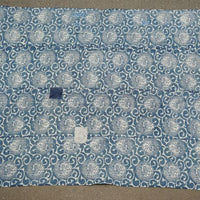

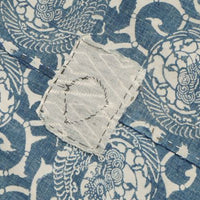

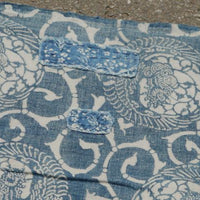
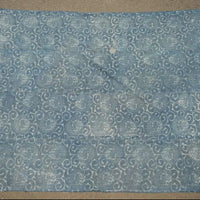
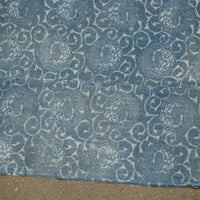
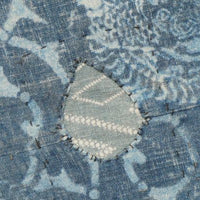

Antique Indigo Katazome Futon-ji – Phoenix Arabesque, 4 Panels Wide
A richly patterned piece of antique Japanese textile history
This hand-stitched futon-ji—futon-ji meaning a futon cover pieced from narrow handwoven panels—once served as a functional household textile in rural Japan. Before industrial looms, families wove cotton in narrow strips on small home looms, then joined them edge-to-edge to create the large rectangles needed for thick, hand-stuffed bedding. These covers were used daily, washed hard, and repaired over many years, making surviving examples like this increasingly rare.
The design on this textile was created using katazome, a traditional Japanese resist-dye method in which artisans brushed a rice-flour paste through hand-cut mulberry-paper stencils (katagami). After the paste dried, the cloth was dipped multiple times into natural indigo vats. When the resist was washed away, crisp pale motifs emerged against the deep indigo ground.
This textile features arabesque scrolls with phoenix elements—the mythical hō-ō, a symbol of renewal, protection, and auspicious beginnings. Such motifs were often chosen with intention and may hint that this futon-ji was originally made for a special household milestone or as part of a young woman’s trousseau.
Age & Historical Context
Based on its materials, construction, stencil style, and sewing techniques, this futon-ji most likely dates to 1930–1945 (early Shōwa period). This estimation is supported by:
-
Handwoven cotton typical of pre-industrial rural households
-
Katazome stencil-work still widely used before the postwar rise of mass-printed fabrics
-
Coarse cotton repairs and patching methods consistent with early–mid 20th-century rural mending practices
-
A level of wear and patina that develops only over many decades
Because it predates the postwar textile industry and exhibits characteristics of early Shōwa craftsmanship, it is appropriate to classify this piece as antique.
Condition
Over time this futon-ji has developed the character people prize in boro textiles: softened threads, gentle fading, and hand-applied patches that speak to years of repair and reuse. These signs of care are not flaws—they are part of the textile’s long life and the values of thrift, respect, and craftsmanship embedded in Japanese household cloth.
Condition: Stains, fading, scuffs, small holes, and patches consistent with age and long use. Clean overall, with some fuzzy batting adhered to the back from its former use as a futon cover.
Dimensions: 50.5" × 61" (approx. 128 × 155 cm)
Measured width suggests 4 handwoven panels, each originally around 13.5–14" wide before seams and shrinkage—typical of small home looms used in rural Japan.
Made in Japan









